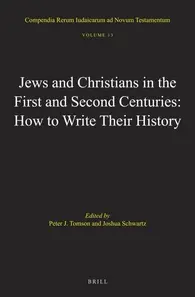

Jews and Christians in the First and Second Centuries: How to Write Their History
in Compendia Rerum Iudaicarum ad Novum Testamentum
Publisher
Brill
Published
10/1/2014
ISBN-13
9789004278394
The papers in this volume are organized around the ambition to reboot the writing of history about Jews and Christians in the first two centuries CE. Many are convinced of the need for a new perspective on this crucial period that saw both the birth of rabbinic Judaism and apostolic Christianity and their parting of ways. Yet the traditional paradigm of Judaism and Christianity as being two totally different systems of life and thought still predominates in thought, handbooks, and programs of research and teaching. As a result, the sources are still being read as reflecting two separate histories, one Jewish and the other Christian.
The contributors to the present work were invited to attempt to approach the ancient Jewish and Christian sources as belonging to one single history, precisely in order to get a better view of the process that separated both communities. In doing so, it is necessary to pay constant attention to the common factor affecting both communities: the Roman Empire. Roman history and Roman archaeology should provide the basis on which to study and write the shared history of Jews and Christians and the process of their separation.
A basic intuition is that the series of wars between Jews and Romans between 66 and 135 CE – a phenomenon unrivalled in antiquity – must have played a major role in this process. Thus the papers are arranged around three focal points: (1) the varieties of Jewish and Christian expression in late Second Temple times, (2) the socio-economic, military, and ideological processes during the period of the revolts, and (3) the post-revolt Jewish and Christian identities that emerged. As such, the volume is part of a larger project that is to result in a source book and a history of Jews and Christians in the first and second centuries.
The contributors to the present work were invited to attempt to approach the ancient Jewish and Christian sources as belonging to one single history, precisely in order to get a better view of the process that separated both communities. In doing so, it is necessary to pay constant attention to the common factor affecting both communities: the Roman Empire. Roman history and Roman archaeology should provide the basis on which to study and write the shared history of Jews and Christians and the process of their separation.
A basic intuition is that the series of wars between Jews and Romans between 66 and 135 CE – a phenomenon unrivalled in antiquity – must have played a major role in this process. Thus the papers are arranged around three focal points: (1) the varieties of Jewish and Christian expression in late Second Temple times, (2) the socio-economic, military, and ideological processes during the period of the revolts, and (3) the post-revolt Jewish and Christian identities that emerged. As such, the volume is part of a larger project that is to result in a source book and a history of Jews and Christians in the first and second centuries.
- Introduction
- I. Varieties of Judaism and Christianity in Late Second Temple Times
- Paula Fredriksen, How Later Contexts Affect Pauline Content, or: Retrospect is the Mother of Anachronism
- Eyal Regev, Flourishing before the Crisis: Mapping Judaean Society in the First Century CE
- Baudouin Decharneux, The Carabas Affair (in Flacc 36-39): An Incident Emblematic of Philo’s Political Philosophy
- Huub van de Sandt, The Jewishness of Jude–James–Hebrews in Light of Purity
- II. The Period of the Revolts 66-135 CE
- James B. Rives, Animal Sacrifice and Political Identity in Rome and Judaea
- Steve Mason, Why Did Judaeans Go to War with Rome in 66-67 CE? Realist-Regional Perspectives
- Adrian Goldsworthy, ‘Men Casually Armed against Fully Equipped Regulars’: The Roman Military Response to Jewish Resistance 63 BCE – 135 CE
- Joshua Schwartz, Yavne Revisited: Jewish ‘Survival’ in the Wake of the War of Destruction
- J. Andrew Overman, The Destruction of the Temple and the Conformation of Judaism and Christianity
- Zeev Safrai,Socio-Economic and Cultural Developments in the Galilee from the Late First to the Early Third Century CE
- III. Post-Revolt Jewish and Christian Identities
- John M.G. Barclay, ‘Jews’ and ‘Christians’ in the Eyes of Roman Authors c. 100 CE
- Marius Heemstra, The Fiscus Judaicus: Its Social and Legal Impact, and a Possible Relation with Josephus’ Antiquities
- Peter J. Tomson, The Didache, Matthew, and Barnabas as Sources for Early Second Century Jewish and Christian History
- Adiel Schremer, Beyond Naming: Laws of Minim in Tannaic Literature and the Early Rabbinic Discourse of Minut
- Albert I. Baumgarten, The Rule of the Martian in the Ancient Diaspora: Celsus and His Jew
- Ishay Rosen-Zvi, Yetser Ha-Ra and Daimones: A Shared Jewish and Christian Discourse